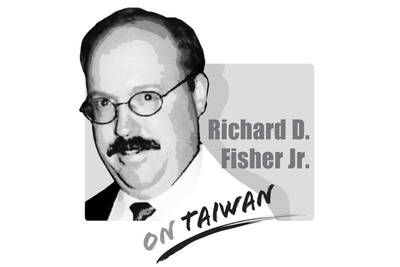After US Vice President J.D. Vance’s hostile speech at February’s Munich Security Conference and US President Donald Trump’s shameful treatment of Ukrainian President Volodymyr Zelenskiy during his Oval Office visit later that month, even the most naive Europeans were forced to confront a sobering reality: The US, under Trump, is no longer on their side.
To be sure, Trump’s unpredictability leaves room for sudden policy reversals, particularly when it comes to the strongmen he openly admires. His recent criticism of Russian President Vladimir Putin suggests growing frustration with his refusal to agree to a ceasefire in Ukraine. Similarly, Trump has noticeably distanced himself from Israeli Prime Minister Benjamin Netanyahu, as evidenced by his overtures toward Iran and multibillion-dollar chip deals with the Gulf states.
That said, it is clear that the transatlantic alliance has entered an especially difficult period — worse than during Trump’s first term.
Notably, Trump’s attacks are not limited to specific countries and their leaders, but extend to the EU itself. He despises the EU — a supranational, liberal project fundamentally incompatible with his nationalist worldview. In Trump’s eyes, the EU and NATO have long enabled European countries to take advantage of the US.
However, viewing the emerging transatlantic divide as geopolitical is misleading. The split is ideological.
On one side is an illiberal, extremist project led by Trump and his allies in Europe; on the other are those determined to preserve liberal democracy, rooted in the 18th-century Enlightenment principles that have guided the West since 1945.
Trump’s administration and supporters promote ideas, ranging from nationalist populism to Silicon Valley libertarianism, that resonate in Europe, where leaders such as Hungarian Prime Minister Viktor Orban, Slovakian Prime Minister Robert Fico, Italian Prime Minister Giorgia Meloni (who has, however, moderated her rhetoric since taking office in 2022), and opposition parties champion similar illiberal views.
To be sure, Romanians recently rejected far-right candidate George Simion in favor of his pro-EU liberal opponent, Nicusor Dan, but Europe’s political landscape remains in flux. Voters in Poland might soon elect a president backed by the far-right Law and Justice Party, and Russian interference — particularly in Romania’s election — has been widespread and well-documented.
As French President Emmanuel Macron noted in January, the global alliance of far-right populist forces reflects the emergence of a “reactionary international.”
On the other side of Europe’s political divide are the leaders committed to defending liberal democracy: Macron, German Chancellor Friedrich Merz, British Prime Minister Keir Starmer (whose party’s recent landslide victory ended 14 consecutive years of Conservative rule), Polish Prime Minister Donald Tusk; and European Commission President Ursula von der Leyen. Their closest ideological counterparts in the US include centrist Republicans and moderate Democrats. The former have largely disappeared from the political map; the latter remain disoriented, fragmented, and without clear leadership in the wake of Trump’s re-election.
As the liberal-democratic camp struggles to regroup, its illiberal adversaries are proving far more coordinated. For years, far-right intellectuals and politicians on both sides of the Atlantic have engaged in frequent and intense exchanges over shared grievances, such as immigration and the perceived moral decay of the West.
So far, efforts to establish a transatlantic “populist international” have yielded only limited progress, mainly because the practical interests of the groups often clash.
However, that did not deter Trump from inviting several prominent figures from Europe’s radical right — including Reform UK leader Nigel Farage, French far-right polemicist and Reconquete leader Eric Zemmour and Alice Weidel of Alternative fur Deutschland — to his inauguration. In many ways, Trump himself serves as a symbolic figurehead linking these otherwise disparate movements.
Liberal thinkers have lacked their illiberal counterparts’ strategic focus. For decades, relations among Western democracies have evolved naturally through established channels and institutions, with political leaders reaffirming their shared democratic values during official visits.
Given that liberal values underpinned the Western-led international order, there appeared to be little need for deeper reflection or debate about the importance of democracy and human rights. Liberalism was like water in an aquarium: essential, yet invisible to the fish. Western academics, writers and mainstream commentators operated within this framework without questioning its underlying assumptions.
With the rise of Trump, Orban and other far-right demagogues, these assumptions can no longer be taken for granted. Liberal democrats must return to first principles and urgently reinvigorate dialogue between moderates in North America and Europe. Beyond symbolic gestures and moral support, political leaders should engage with like-minded intellectuals, journalists and policymakers to foster cross-pollination and help forge a shared democratic vision for the future.
There is much to discuss: How can younger voters be convinced of the enduring value of democracy and the rule of law over the allure of charismatic strongmen? How can we devise economic policies that support workers without undermining the international trade system or accelerating climate change? And how should liberals respond to immigration pressures?
Transatlantic discussion of these issues could play a vital role in revitalizing liberal ideals and developing political platforms capable of defending democratic governance in the years ahead.
Laurence Nardon is head of the Americas Program at the Institut francais des relations internationales.
Copyright: Project Syndicate

As the Chinese Communist Party (CCP) and its People’s Liberation Army (PLA) reach the point of confidence that they can start and win a war to destroy the democratic culture on Taiwan, any future decision to do so may likely be directly affected by the CCP’s ability to promote wars on the Korean Peninsula, in Europe, or, as most recently, on the Indian subcontinent. It stands to reason that the Trump Administration’s success early on May 10 to convince India and Pakistan to deescalate their four-day conventional military conflict, assessed to be close to a nuclear weapons exchange, also served to
China on May 23, 1951, imposed the so-called “17-Point Agreement” to formally annex Tibet. In March, China in its 18th White Paper misleadingly said it laid “firm foundations for the region’s human rights cause.” The agreement is invalid in international law, because it was signed under threat. Ngapo Ngawang Jigme, head of the Tibetan delegation sent to China for peace negotiations, was not authorized to sign the agreement on behalf of the Tibetan government and the delegation was made to sign it under duress. After seven decades, Tibet remains intact and there is global outpouring of sympathy for Tibetans. This realization
After India’s punitive precision strikes targeting what New Delhi called nine terrorist sites inside Pakistan, reactions poured in from governments around the world. The Ministry of Foreign Affairs (MOFA) issued a statement on May 10, opposing terrorism and expressing concern about the growing tensions between India and Pakistan. The statement noticeably expressed support for the Indian government’s right to maintain its national security and act against terrorists. The ministry said that it “works closely with democratic partners worldwide in staunch opposition to international terrorism” and expressed “firm support for all legitimate and necessary actions taken by the government of India

The recent aerial clash between Pakistan and India offers a glimpse of how China is narrowing the gap in military airpower with the US. It is a warning not just for Washington, but for Taipei, too. Claims from both sides remain contested, but a broader picture is emerging among experts who track China’s air force and fighter jet development: Beijing’s defense systems are growing increasingly credible. Pakistan said its deployment of Chinese-manufactured J-10C fighters downed multiple Indian aircraft, although New Delhi denies this. There are caveats: Even if Islamabad’s claims are accurate, Beijing’s equipment does not offer a direct comparison